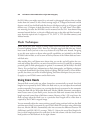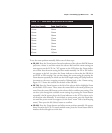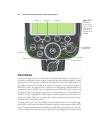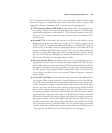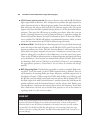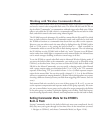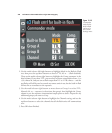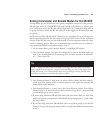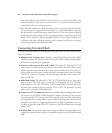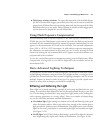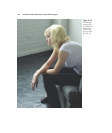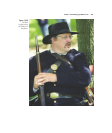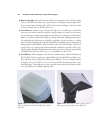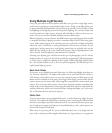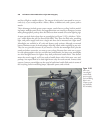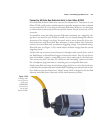
7. Once the modes for all the flash units have been set on the master flash, press
Function Button 2 and rotate the selector dial to set a channel number that the
master flash will use to control its groups.
8. Now take each of the remote flash units and set the correct group and channel num-
ber you want to use. Just press Function Button 1 on each remote flash, and rotate
the selector dial to specify the group name. Press OK. Then press Function Button
2 and rotate the selector dial to choose the channel number, and then press the OK
button. You’re all set! If a Nikon-compatible flash is used as a remote, both the rear
and front ready lights will blink when the unit is charged, at full power, and com-
municating properly with the Master flash.
Connecting External Flash
You have five basic choices for linking an external flash unit to your Nikon D7000.
They are as follows:
■ Mount on the accessory shoe. Sliding a compatible flash unit into the Nikon
D7000’s accessory shoe provides a direct connection. With a Nikon dedicated flash,
all functions of the flash are supported.
■ Connect to the accessory shoe with a cable. The Nikon SC-28 and SC-29 TTL
coiled remote cords have an accessory shoe on one end of a nine-foot cable to accept
a flash, and a foot that slides into the camera accessory shoe on the other end, pro-
viding a link that is the same as when the flash is mounted directly on the camera.
The SC-29 version also includes a focus assist lamp, like that on the camera, SB-
900, and SB-700.
■ Multi-flash cables. The Nikon SC-27/SC-26 TTL Multi-Flash Sync Cords can be
used to connect TTL flash units to each other or through the AS-10 TTL Multi-
Flash Adapter or SC-28 TTL Remote Cord for multi-flash operation. However,
this three-pin connector does not support i-TTL or D-TTL operation. You may
wish to use it with older Nikon flash units.
■ Connect to a PC/X connector. Some external flash units, including studio units,
can connect to the Nikon D7000 through an adapter that clips in the accessory
shoe and provides a PC/X connector. These adapters can be especially useful if they
are combined with a voltage limiter so you needn’t fear frying your camera with an
older flash unit that has a triggering voltage that’s too high. I sometimes use a wire-
less flash trigger that plugs into a PC connector, and sets off flash units through
radio waves.
■ Wireless link. As described earlier in this chapter, a Nikon electronic flash can be
triggered by another Master flash in Commander mode or by the RU-800 infrared
unit.
David Busch’s Nikon D7000 Guide to Digital SLR Photography430



